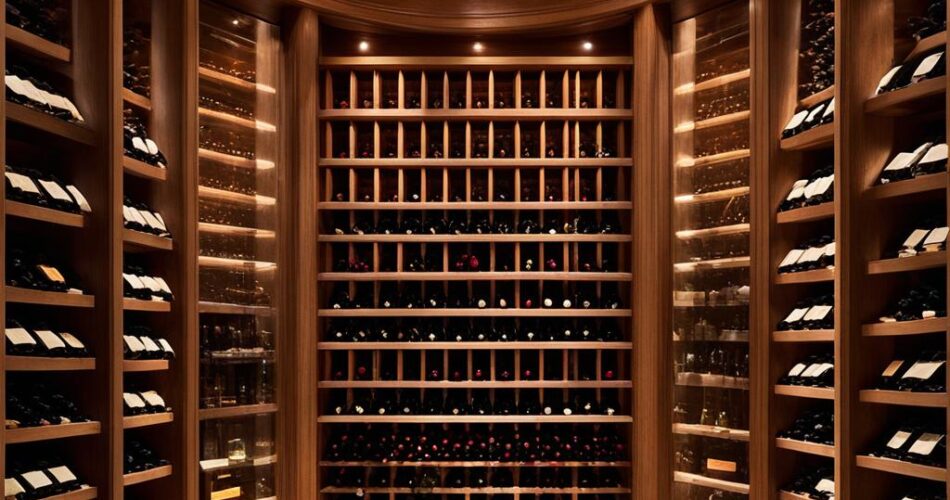Wine enthusiasts, get ready to elevate your home! Custom wine cellars are now the pinnacle of home design. These spaces preserve your bottles and add luxury to your living area.
Picture a room with soft LED lights showcasing your favorite vintages. That’s the allure of well-crafted wine storage. There’s a perfect cellar design for everyone, from novices to seasoned collectors.
Home wine cellars are more than storage; they’re a bold statement. With the right mix of function and style, your cellar becomes your home’s centerpiece.
These cellars range from temperature-controlled havens to artistic displays. The options are as diverse as the wines they house.
Key Takeaways:
- Custom wine cellars enhance home value and wine preservation
- Ideal storage conditions include 55-59°F and 50-70% humidity
- LED lighting is preferred for minimal heat emission
- Wood and metal racks offer different benefits for wine storage
- Personalized designs cater to individual collection needs
The Benefits of Custom Wine Cellars for Wine Enthusiasts
Custom wine cellars blend functionality and luxury for wine lovers. These rooms provide ideal conditions for wine preservation. Proper storage at 55°F and 50-70% humidity keeps wines tasting great.
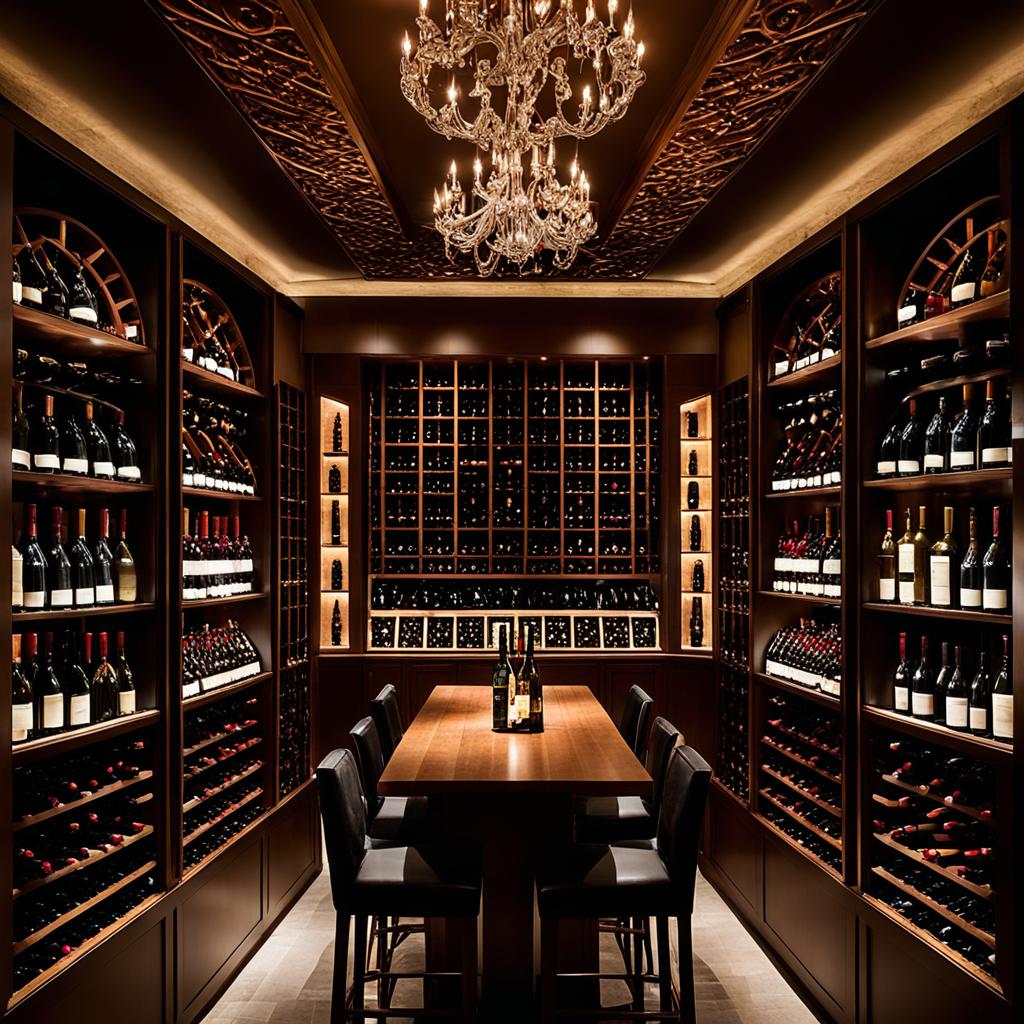
A well-designed wine cellar boosts home value, especially in markets like Dallas, Texas. These spaces create intimate settings for wine tasting parties. They can comfortably host up to 12 people for an ideal experience.
Custom shelving and racks maximize space for your prized bottles. This improves organization and increases the resale value of your collection. It also enhances the overall aesthetic appeal of your cellar.
- Precise temperature and humidity control
- Increased property value
- Ideal space for wine tasting events
- Efficient storage and organization
Investing in a custom wine cellar ensures optimal storage conditions. Temperature control systems and humidity tools help wines age perfectly. You can tailor every aspect of your cellar to your style and needs.
Assessing Your Wine Collection and Storage Needs
A thorough wine collection assessment is key to creating the perfect storage space. It helps determine your wine storage needs. This ensures your prized bottles are kept in optimal conditions.
Determining Bottle Size and Quantity
Bottle size plays a crucial role in planning your wine cellar. Standard 750ml bottles need less space than larger formats like magnums or jeroboams. Take inventory of your collection, noting the various sizes and quantities.

Considering Consumption Frequency
Your wine drinking habits impact cellar design. Regular drinkers might prioritize accessibility, while collectors may focus on long-term storage. WTSO.com suggests reviewing your collection regularly to keep it manageable.
Their My Cellar app can help track inventory and organize your wines digitally.
Planning for Future Acquisitions
Don’t forget to plan for future wine purchases when assessing storage needs. WTSO offers temperature-controlled storage for up to 12 months. This is ideal for expanding collections without immediate space concerns.
Consider leaving room for growth in your cellar design. This will accommodate new purchases and gifts.
| Wine Type | Ideal Storage Temperature | Humidity Level |
|---|---|---|
| Red Wine | 55-65°F (12-18°C) | 70% |
| White Wine | 49-55°F (9-13°C) | 70% |
| Sparkling Wine | 45°F (7°C) | 70% |
By considering these factors, you’ll create a wine cellar that meets your current needs. It will also adapt to your evolving collection and preferences.
Key Factors in Designing Your Wine Cellar
Designing a perfect wine cellar requires careful planning. The cellar’s location is crucial for maintaining ideal conditions. Basements are popular choices, offering naturally cool and dark environments.
Insulation is vital for a stable climate. Spray foam insulation is highly recommended for climate-controlled wine cellars. It ensures consistent temperature and humidity levels, protecting your collection from harmful fluctuations.
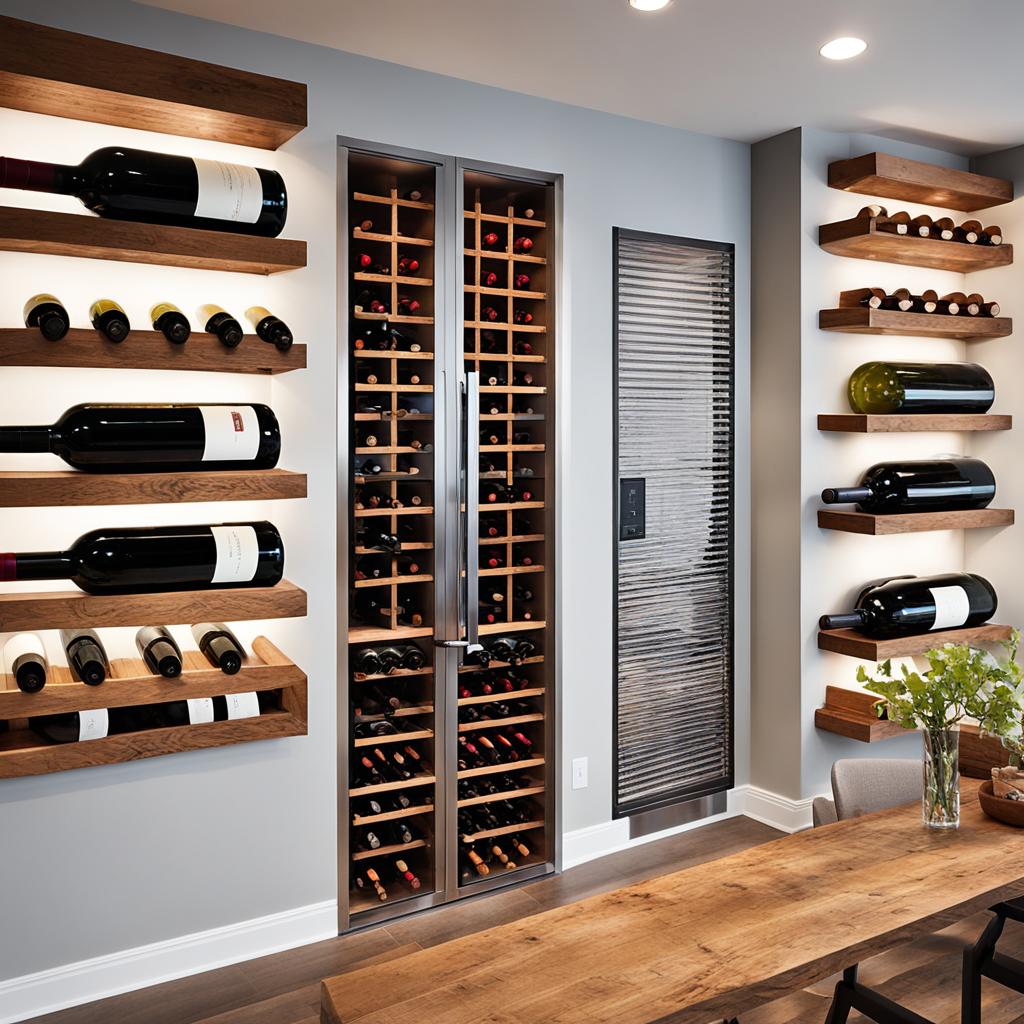
Proper ventilation prevents mold growth and musty odors. Installing vents or fans helps circulate air and maintain optimal conditions. Consider wine cellar refrigeration systems from brands like CellarPro or WhisperKOOL for precise control.
| Design Factor | Recommendation |
|---|---|
| Temperature | 55-60°F (13°C) |
| Humidity | 60-70% |
| Insulation | Spray foam |
| Door | Dual-paned glass |
| Flooring | Reclaimed oak barrel |
Focusing on these key factors will create a functional and stylish space. Your wine cellar will preserve your collection and add value to your home.
Temperature and Humidity Control: Essential for Wine Preservation
Wine cellar temperature and humidity control are vital for proper wine preservation. The ideal storage temperature is between 45°F and 65°F, with 55°F being perfect. This range allows for slow aging and flavor development.
Ideal Temperature Range for Wine Storage
White wines prefer cooler temperatures, around 10°C to 12°C. Reds thrive between 12°C and 14°C. Keeping a steady temperature is key to preventing spoilage and preserving quality.
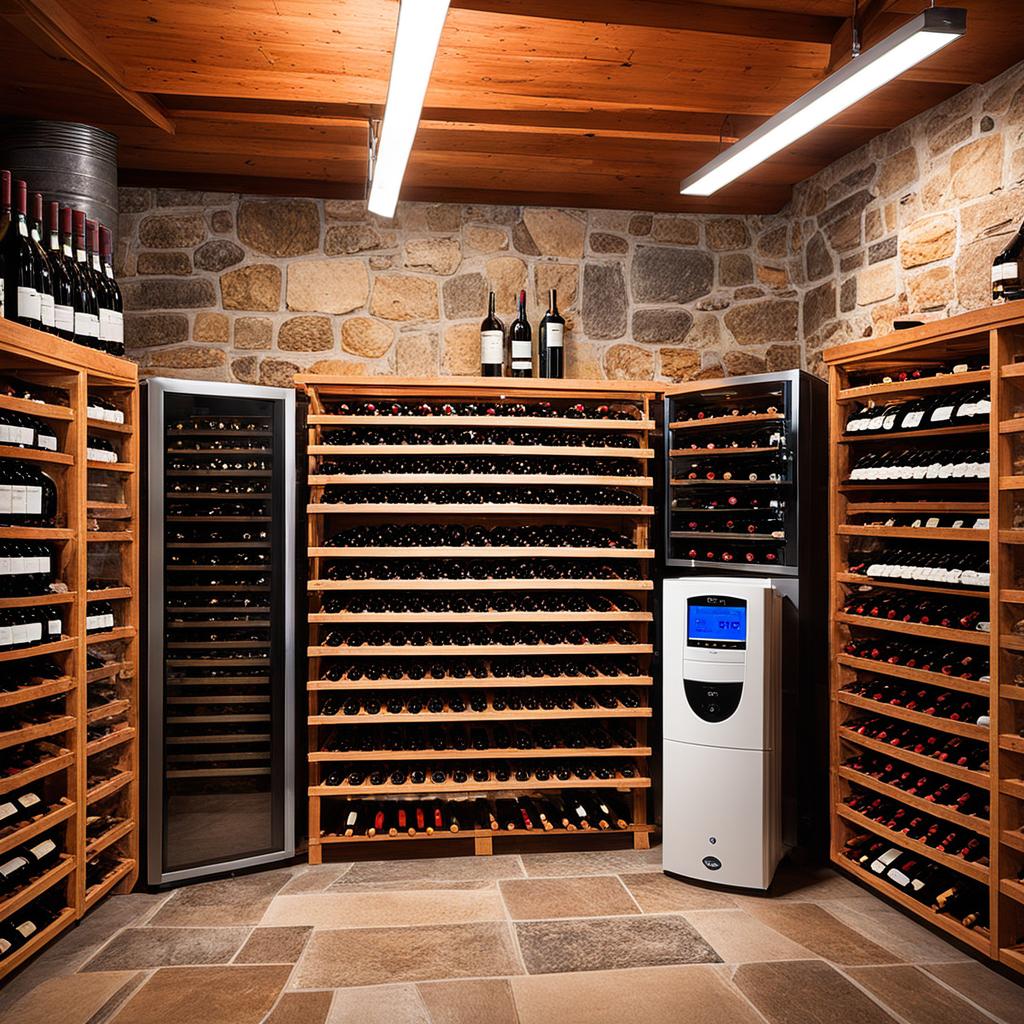
Optimal Humidity Levels
Humidity control is crucial for wine preservation. The ideal level is between 60% and 70%. This range keeps corks from drying out and maintains the wine’s seal.
Too much humidity can cause mold growth. Low humidity can damage cork integrity.
Choosing the Right Wine Cellar Cooling System
Picking the right cooling system is essential for optimal conditions. Options include self-contained units, split systems, and through-the-wall units.
- Self-contained units: Ideal for small to medium-sized cellars up to 1,000 cubic feet
- Split systems: Suitable for larger wine cellars
- Through-the-wall units: Offer good temperature and humidity control for small to medium spaces
Consider your cellar size, budget, and needs when choosing a system. The WhisperKOOL Extreme 3500tiR operates quietly at 51 dB.
The CellarPro Air Handler Split 8500 can cool up to 2,500 cubic feet. It’s perfect for large collections.
“If a $1,000 cooling unit represents less than 25% of your annual wine-buying budget, it’s time to consider investing in one.”
Investing in proper cooling systems ensures your collection ages beautifully. It maintains quality and value for years to come.
Lighting and Decor: Creating an Elegant Atmosphere

Wine cellar lighting is key to crafting an elegant atmosphere for your collection. LED lights are popular for modern cellars. They offer energy efficiency and minimal heat emission.
Strategic light placement highlights bottles without compromising quality. Reclaimed wood accents add warmth and character to cellar decor. Pairing wood with metal or glass elements creates a rustic-contemporary blend.
Glass walls illuminated by well-placed lights can create a stunning effect. Consider these lighting options for your cellar:
- Wall sconces for gentle illumination of wooden racks
- LED strip lights for under-shelf and cabinet lighting
- Pendant lights for a touch of sophistication
- Recessed lights with dimmers for mood setting
- Track lighting for highlighting specific areas
Include a wine tasting area in your cellar design. This addition enhances the space’s functionality and creates an inviting ambiance. A well-designed tasting area transforms your cellar into a captivating wine sanctuary.
“A thoughtfully lit and decorated wine cellar doesn’t just store wine; it tells a story and invites exploration.”
Careful lighting and decor choices can elevate your wine cellar. These elements preserve your collection and showcase it beautifully. Your cellar can become a space that both protects and displays your wines.
Wine Racks and Shelving: Maximizing Storage and Style
Wine racks and shelving are essential for preserving your collection and showcasing your passion. The right storage can improve wine longevity and cellar aesthetics. Proper storage solutions make a big difference in your wine experience.
Wooden vs. Metal Wine Racks
Wooden wine racks offer classic appeal and natural insulation. They’re perfect for creating a traditional cellar atmosphere. Metal racks bring a modern touch to your space and are durable.
Metal options are easy to clean and often more affordable than wooden ones. Both types have unique benefits for wine enthusiasts.
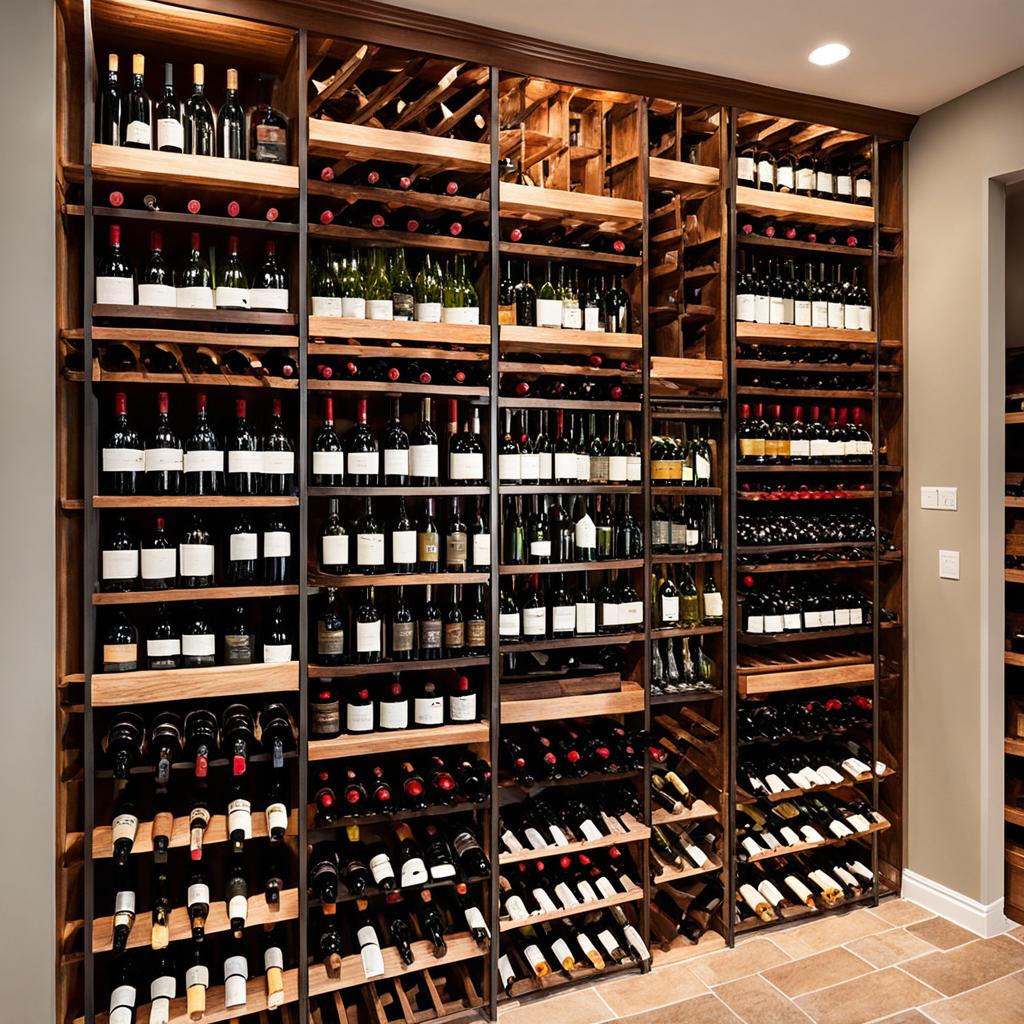
Horizontal vs. Vertical Storage Options
Horizontal storage is ideal for cork-sealed bottles, keeping the cork moist to prevent oxidation. Vertical storage works well for screw-cap bottles and allows easier label visibility.
Many wine lovers use both storage methods. This combination accommodates different bottle types in their collection.
Custom Shelving Solutions
Custom wine shelving offers tailored storage for your unique collection. These solutions maximize space utilization, from wall-mounted racks to under-stairs designs.
Custom shelving can accommodate various bottle sizes and shapes. This ensures your prized vintages are stored safely and stylishly.
| Storage Type | Advantages | Best For |
|---|---|---|
| Wooden Racks | Natural insulation, classic look | Traditional cellars |
| Metal Racks | Durability, easy cleaning | Modern cellars |
| Horizontal Storage | Keeps corks moist | Cork-sealed bottles |
| Vertical Storage | Easy label visibility | Screw-cap bottles |
| Custom Shelving | Space optimization | Unique collections |
Effective wine storage depends on choosing a system that fits your collection and cellar design. Consider your bottle types, collection size, and style preferences when selecting storage.
With the right racks or shelving, you’ll create a functional and stylish space for your wines. Your collection deserves the best care and presentation possible.
Home Wine Cellar Ideas: From Basement to Bespoke Designs
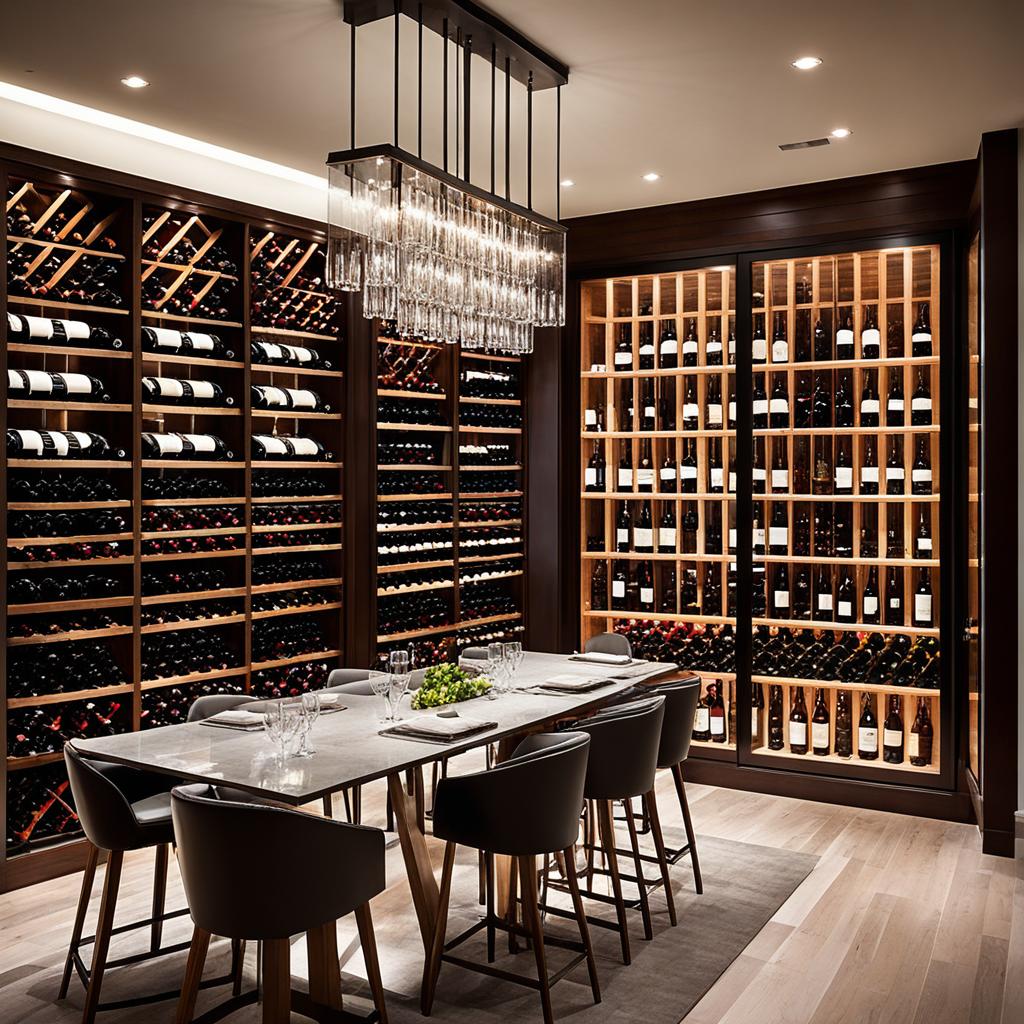
Wine enthusiasts have many options for home cellars. From basements to custom designs, there’s a solution for every space and style. These cellars offer perfect storage and showcase your passion for wine.
Basement cellars are a popular choice. They provide a naturally cool environment for wine storage. Recent research highlighted over 57 basement cellar designs, showing their widespread appeal.
Small space cellars are ideal for limited areas. These compact designs use every inch wisely. They allow you to store prized bottles even in tight spots.
Wine rooms go beyond simple storage. Many collectors create elegant spaces for tasting. Imagine a room with wooden racks, soft lighting, and cozy seating.
| Design Element | Popular Options |
|---|---|
| Materials | Wood, Glass, Stone, Brick, Marble, Concrete |
| Styles | Rustic, Contemporary, Industrial, Mediterranean, Traditional, Elegant |
| Features | Spiral Staircases, Tasting Tables, Chandeliers, Marble Countertops, Herringbone Tile Floors |
| Lighting | Spotlights, Chandeliers, LED Fixtures, Accent Lights |
Bespoke cellars offer ultimate personalization. These custom designs can include unique elements like vintage decor or wine barrel features. The possibilities are truly endless with custom cellars.
“A well-designed wine cellar is not just about storage – it’s about creating a space that reflects your passion for wine.”
Creating a controlled environment is crucial for any cellar design. The ideal temperature for long-term wine storage is 55°F to 59°F. Humidity levels should range from 60% to 70%.
Custom Wine Cellar Doors: Combining Security and Aesthetics
Custom wine cellar doors protect your prized collection while adding elegance to your home. They blend functionality with style, offering both security and visual appeal.
Material Choices: Wood, Glass, or Combination
Wine enthusiasts can choose from various materials for their custom wine cellar doors. Wooden doors, made from premium hardwoods like African Mahogany or Walnut, offer durability and classic charm.
Glass doors provide a modern look and showcase your collection. For a unique blend, consider combining wood frames with glass panels or wrought iron grills.
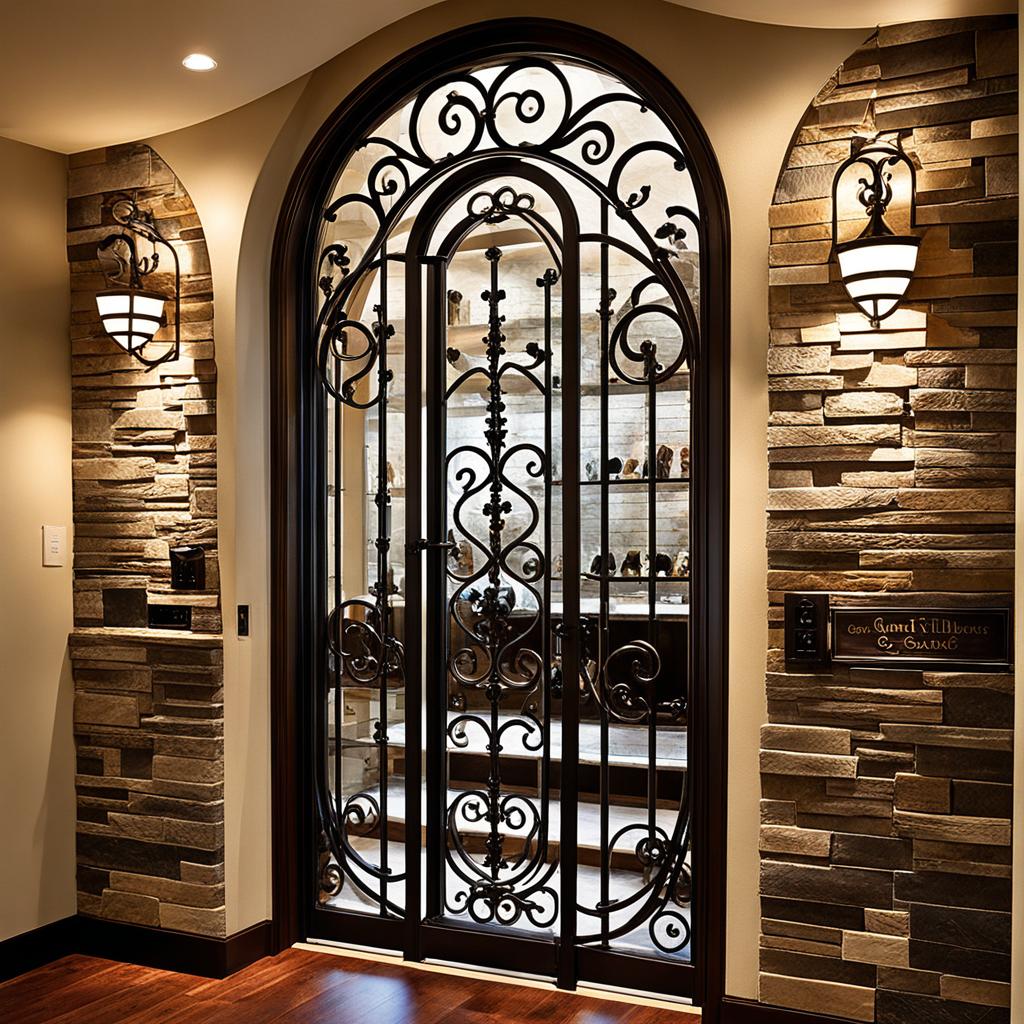
Insulation and Sealing Features
Insulated wine cellar doors are crucial for maintaining optimal storage conditions. Double-paned tempered glass and automatic door bottoms help regulate temperature and humidity.
Laminated Veneer Lumber (LVL) technology enhances structural strength and insulation properties. This ensures your wines age perfectly in the ideal environment.
Security Considerations for Valuable Collections
Wine cellar security is vital for protecting your investment. Metal doors, made from high-quality steel or iron, offer unmatched durability and security.
These doors can be equipped with advanced locking systems. They resist corrosion and wear, providing peace of mind for collectors.
| Door Type | Key Features | Benefits |
|---|---|---|
| Wooden | Premium hardwoods, LVL core | Classic look, durability |
| Glass | Double-paned tempered glass | Modern aesthetic, UV protection |
| Metal | High-quality steel or iron | Enhanced security, corrosion-resistant |
Consider material, insulation, and security features when selecting custom wine cellar doors. These factors create the perfect entrance for your wine sanctuary.
Seek expert guidance to design doors that match your unique style and protection needs. Professionals can help you make the best choice for your collection.
Conclusion: Crafting Your Perfect Home Wine Sanctuary
A home wine sanctuary is more than just storage. It’s a space that celebrates your love for wine. Custom wine cellars are becoming popular as more Americans enjoy wine regularly.
Wine cellar designs now cater to various tastes and spaces. Styles range from sleek glass walls to rustic wooden racks. Even smaller homes can have charming wine showcases.
A well-designed wine cellar can be a valuable investment. Luxury home buyers often pay extra for this feature. It creates a sophisticated space for entertaining and enjoying your collection.
Your choice of racks will reflect your personal style. It will also enhance your wine experience. The perfect sanctuary balances form and function.
It creates an ideal environment for preserving and showcasing wines. Cheers to sipping in style in your own wine oasis!
